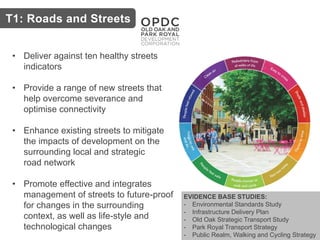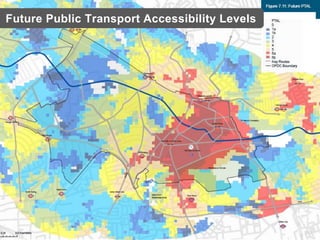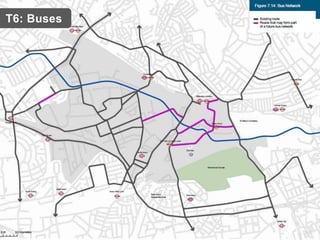OPDC revised draft Local Plan presentation - Transport
- 1. Revised draft Local Plan Transport July 2017
- 2. DELIVERY & IMPLEMENTATION DEVELOPMENT MANAGEMENT POLICIES PLACES STRATEGIC POLICIES SPATIAL VISION INTRODUCTION New evidence base and responses to consultation DELIVERY & IMPLEMENTATION THEMATIC POLICIES PLACES OVERARCHING SPATIAL POLICIES SPATIAL VISION & OBJECTIVES INTRODUCTION REGULATION 18 REGULATION 19 Old and new structure
- 3. SP7: CONNECTING PEOPLE AND PLACES CHAPTER 7: TRANSPORT T1: Roads and Streets T2: Walking T3: Cycling T4: Parking T5: Rail T6: Buses T7: Freight, servicing and deliveries T8: Construction T9: Transport Assessments and Travel Plans DELIVERY & IMPLEMENTATION DEVELOPMENT MANAGEMENT POLICIES PLACES STRATEGIC POLICIES SPATIAL VISION INTRODUCTION Existing and new evidence base REGULATION 19 Local Plan focus
- 4. • Minimising traffic congestion • Support and objections to stringent Car Parking controls • Cycle parking • Delivering pedestrian and cycle friendly streets • Tackling construction and freight issues Key issues
- 5. • A40 Study • Bus Strategy • Car Parking Study • Infrastructure Delivery Plan • North Acton Station Feasibility Study • Old Oak Strategic Transport Study • Park Royal Transport Strategy • Public Realm, Walking and Cycling Strategy • Willesden Junction Station Feasibility Study Supporting Studies
- 6. Supporting Studies – key overview Park Royal Transport Strategy Strategic assessment of the existing transport provision in Park Royal, the impact of the planned future growth and identification of the transport interventions required to mitigate those impacts. Infrastructure Delivery Plan Identifies the infrastructure required to support the regeneration of the area. North Acton Station Feasibility Study Investigates the options for enhancing the capacity and accessibility of North Acton station and the options for improving the permeability of the site. Bus Strategy Shows how the current bus network could be adjusted to deliver the best outcome with regards to optimising the bus network to unlock Old Oak and Park Royal. Old Oak Strategic Transport Study Strategic assessment of the existing transport provision in Old Oak, the impact of the planned future growth and identification of the transport interventions required to mitigate those impacts. Public Realm, Walking and Cycling Strategy Provides a framework for delivering an exemplar sustainable, accessible urban environment for Old Oak and Park Royal with high quality public realm and where walking and cycling are comfortable, convenient, safe and efficient choices for people to move around the local area. Car Parking Study Provides a critical review of the proposed parking policy in the Local Plan from a market and viability perspective. A40 Study This study identified the key challenges associated with the A40 and investigated potential long term investment options. Willesden Junction Station Feasibility Study Feasibility study on Willesden Junction Station and Interchange to GRIP 2 level.
- 7. Connecting People and Places • Creating or contributing to a high quality, safe and accessible movement network
- 9. EVIDENCE BASE STUDIES: - Environmental Standards Study - Infrastructure Delivery Plan - Old Oak Strategic Transport Study - Park Royal Transport Strategy - Public Realm, Walking and Cycling Strategy T1: Roads and Streets • Deliver against ten healthy streets indicators • Provide a range of new streets that help overcome severance and optimise connectivity • Enhance existing streets to mitigate the impacts of development on the surrounding local and strategic road network • Promote effective and integrates management of streets to future-proof for changes in the surrounding context, as well as life-style and technological changes
- 10. Affordable Housing Viability Assessment T2: Walking EVIDENCE BASE STUDIES: - Environmental Standards Study - Infrastructure Delivery Plan - Old Oak Strategic Transport Study - Park Royal Transport Strategy - Public Realm, Walking and Cycling Strategy • Deliver new walking routes to enable the delivery of a high quality, safe, direct, accessible and inclusive walking network • Provide new and enhance existing walking infrastructure • Connect to existing and planned pedestrian links in the wider area • Contribute to the network of Legible London signs to improve legibility and wayfinding in Old Oak and Park Royal
- 12. Affordable Housing Viability Assessment T3: Cycling EVIDENCE BASE STUDIES: - Environmental Standards Study - Infrastructure Delivery Plan - Park Royal Transport Strategy - Public Realm, Walking and Cycling Strategy • New and enhanced cycle routes within and to Old Oak and Park Royal • Improved cycling connections to stations • Contribute towards signage to improve cycle wayfinding and legibility • Require high quality, secure, well located, convenient and accessible parking facilities that exceed the standards set out in the London Plan • Contribute towards the provision of cycle hire in Old Oak and Park Royal
- 13. Affordable Housing Viability Assessment T3: Cycling
- 14. Affordable Housing Viability Assessment EVIDENCE BASE STUDIES: • Car Parking Study • Environmental Standards Study • Infrastructure Delivery Plan • Old Oak Strategic Transport Study • Park Royal Transport Strategy T4: Parking • Strongly encourage car-free development within PTALs 4-6b • 0.2 spaces per residential unit elsewhere • Car- free for non-residential developments, but recognises there may be cases where limited car parking can be justified • Ensure car parking is well-designed • Electric vehicle charging (20% active, 80% passive) • Car clubs encouraged
- 15. Affordable Housing Viability Assessment Current Public Transport Accessibility Levels
- 16. Affordable Housing Viability Assessment Future Public Transport Accessibility Levels
- 17. T5: Rail EVIDENCE BASE STUDIES: • Infrastructure Delivery Plan • Old Oak Strategic Transport Study • Park Royal Transport Strategy • Willesden Junction Station Feasibility Study • North Acton Station Feasibility Study • Improving existing and delivering new rail stations • design new rail stations to deliver outstanding design quality and enable future proofing of station design to facilitate future technological advances, rail connections and service changes • include the provision of retail, culture, leisure, town centre and meanwhile uses • manage the demands of competing transport modes and interchange requirements for walking, cycling, buses and taxis • provide step free access from all entrances to platforms • optimise development opportunities on and/or adjacent to the stations and tracks • ensure new rail infrastructure is sensitively designed to integrate with surrounding development
- 18. T5: Rail
- 20. • 2026 Old Oak station opens with: HS2, Elizabeth Line (Crossrail) and the Great Western Mainline • 250,000 passengers per day • 90% the size of Waterloo station • 8 min from central London • 10 min from Heathrow • 38 min from Birmingham Old Oak Common Station
- 21. The site of the largest sub-surface station to be built in the UK
- 22. Proposed HS2 Hybrid Bill design
- 23. Willesden Junction Station GRIP 2 Study - complete Identified three potential options for future and capacity issues today. North Acton Station Pre-feasibility study – complete Indicated need for station improvements and capacity enhancements now. New Hythe Road and Old Oak Common Lane Stations GRIP 3 Study – in progress Identified viaduct and footbridge solutions. Required to alleviate capacity at on Crossrail and at Euston. Known capacity issues on NLL and WLL. Old Oak Common Station Influencing DfT and HS2 Ltd to improve the design of the HS2 Station Rail work to date
- 27. EVIDENCE BASE STUDIES: • Bus Strategy T6: Buses • Enhance existing and provide new bus infrastructure • Ensure that all residents in Old Oak and Park Royal live within 400m of high quality, convenient, safe, sheltered and personally secure passenger waiting and information countdown facilities • Design streets to be served by buses • Ensure that impacts to bus operations resulting from construction activity are mitigated • Provide temporary provision for buses, during the phased development of the OPDC area • Support the roll out of low and zero emission buses
- 29. EVIDENCE BASE STUDIES: • Circular Economy Study • Old Oak Transport Study • Park Royal Transport Strategy T7: Freight, Servicing & Deliveries • Reduce freight and servicing trips through forecasting, requiring Servicing and Delivery Plans and through consolidation centres • Provide off-street servicing facilities • Click and collect • Make use of rail and water for freight • Ensure that the operators of all freight vehicles operating in the area have attained the Silver Fleet Operator Recognition Scheme (FORS) accreditation • Support and enable smart technologies
- 30. EVIDENCE BASE STUDIES: • Circular and Sharing Economy Study • Old Oak Transport Study • Park Royal Transport Strategy T8: Construction • Reduce construction trips through forecasting requiring the production and implementation of Construction Logistics Plan and Construction Code of Practice Utilising consolidation centres • Coordinate construction with adjacent projects to minimise trips • Make use of rail and water for movement of construction materials • Ensure that the operators of all freight vehicles operating in the area have attained the Silver Fleet Operator Recognition Scheme (FORS) accreditation • Deliver measures to ensure safety of pedestrians and cyclists
- 31. Affordable Housing Viability Assessment Affordable Housing Viability Assessment EVIDENCE BASE STUDIES: • Public Realm, walking and cycling study • Old Oak Transport Study • Park Royal Transport Strategy T9: Transport Assessment and Travel Plans • Transport assessments and travel plans should be provided for planning applications exceeding the thresholds in, and produced in accordance with the relevant TfL guidance
- 33. Key issues • Public consultation on the revised draft Local Plan concludes: midnight Monday 11 September 2017 • Autumn 2017: OPDC considers consultation responses and make necessary amendments to the Local Plan • Early 2018: Submit to Secretary of State • Spring 2018: Examination in Public • Summer 2018: Adopt Local Plan Next steps

































